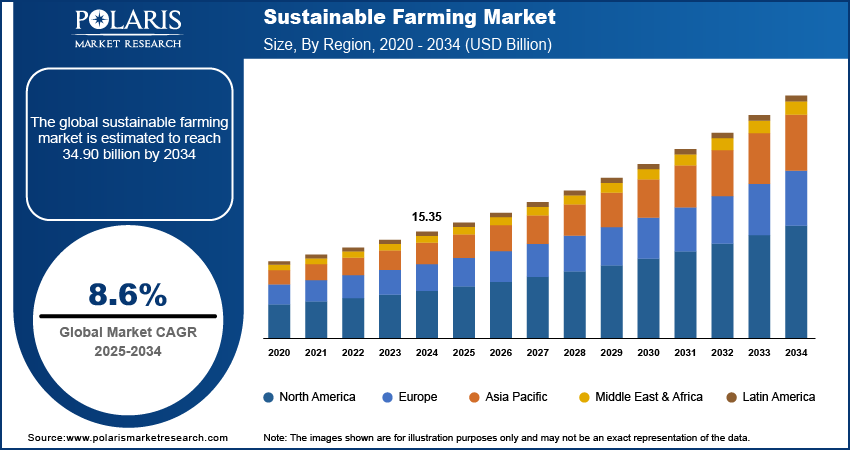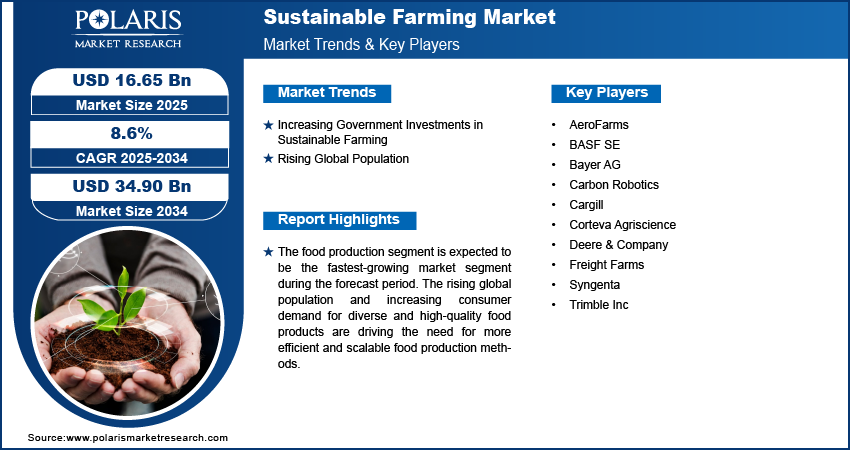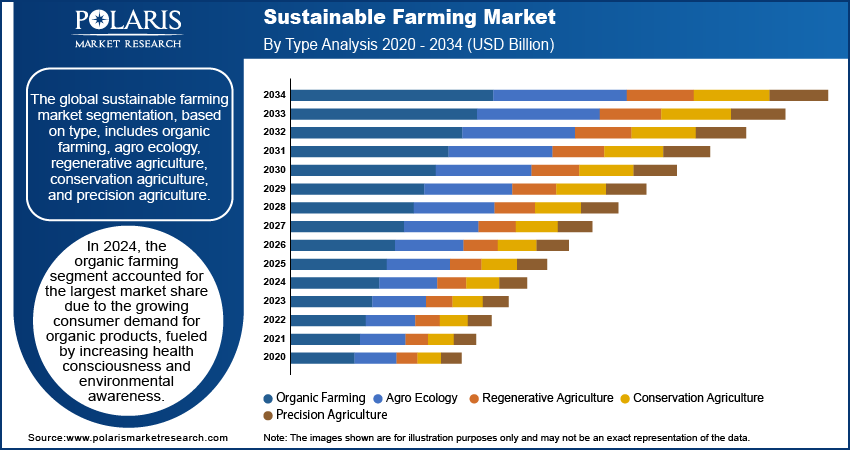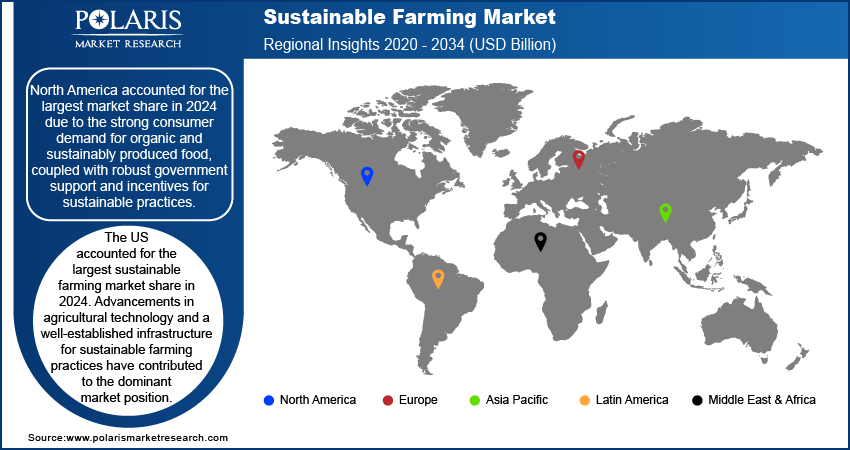
Sustainable Farming Market Size, Share, Trends, Industry Analysis Report: By Type (Food Production, Bioenergy, Environmental Services, Water Management, and Others), Application, and Region (North America, Europe, Asia Pacific, Latin America, and Middle East & Africa) – Market Forecast, 2025–2034
- Published Date:Jan-2025
- Pages: 120
- Format: PDF
- Report ID: PM5348
- Base Year: 2024
- Historical Data: 2020-2023
Sustainable Farming Market Overview
The global sustainable farming market size was valued at USD 15.35 billion in 2024. The market is projected to grow from USD 16.65 billion in 2025 to USD 34.90 billion by 2034, exhibiting a CAGR of 8.6% during 2025–2034.
Sustainable farming is an agricultural practice that aims to meet current food and fiber needs while ensuring that resources are available for future generations. It focuses on methods that protect the environment, maintain soil fertility, conserve water, and support the well-being of farmers and communities. Sustainable farming integrates ecological, economic, and social principles to create a balanced and long-lasting agricultural system. The growing awareness of climate change and its impact on agriculture is a significant driver. Sustainable farming practices such as carbon sequestration through no-till farming and agroforestry play a vital role in reducing greenhouse gas emissions and building resilience to climate change. Furthermore, increasing water scarcity, particularly in arid and semi-arid regions, is leading to the widespread adoption of water-efficient techniques such as drip irrigation, rainwater harvesting, and drought-resistant crop varieties, all of which are contributing to the sustainable farming market development.

To Understand More About this Research: Request a Free Sample Report
The rising adoption of precision farming technologies, such as GPS-guided equipment, drones, and sensors, is enabling more efficient and sustainable farming practices. These technologies allow farmers to optimize inputs, reduce waste, and minimize environmental impact, thereby fueling the sustainable farming market expansion. Moreover, stringent environmental regulations and the introduction of sustainability standards push farmers to adopt sustainable practices. This includes regulations on pesticide use, water management, and carbon emissions.
Sustainable Farming Market Trends
Increasing Government Investments in Sustainable Farming
Governments across the world are intensifying their efforts to accelerate the adoption of sustainable farming practices through a range of financial mechanisms, including subsidies, grants, and incentives. These initiatives encompass substantial support for organic farming, soil conservation efforts, and the integration of renewable energy systems within agricultural operations. For instance, in April 2023, the US Department of Agriculture (USDA) committed over USD 46 million to the Sustainable Agriculture Research and Education (SARE) program. This investment has been instrumental in funding farmer-driven grants and grassroots educational initiatives, leading to the development and implementation of climate-smart solutions on farms. As a result, these increasing investments and the expansion of educational programs are significantly enhancing the demand for sustainable farming practices, thereby driving the sustainable farming market growth.
Rising Global Population
The rising population across the world, with projections estimating nearly 10 billion people by 2050, is escalating demand for food at an exceptional rate. According to estimates compiled by the Food and Agriculture Organization (FAO), the global population will reach 9.3 billion by 2050, necessitating a 60% increase in food production to meet the demands of this growing population. This immense challenge underscores the vital need for sustainable farming practices that significantly boost productivity without depleting natural resources. Moreover, sustainable farming practices enhance the resilience of agricultural systems to climate change, further securing food supplies in the face of environmental uncertainties. As a result, the adoption of sustainable farming is becoming crucial for meeting the future food needs of a rapidly growing global population, thereby driving the sustainable farming market expansion.

Sustainable Farming Market Segment Insights
Sustainable Farming Market Outlook – by Type Insights
The global sustainable farming market segmentation, based on type, includes organic farming, agro ecology, regenerative agriculture, conservation agriculture, and precision agriculture. In 2024, the organic farming segment accounted for the largest market share due to the growing consumer demand for organic products, fueled by increasing health consciousness and environmental awareness. For instance, according to USDA National Agricultural Statistics Service surveys, from 2011 to 2021, certified organic cropland acres expanded by 79%, reaching 3.6 million acres. During the same period, the number of certified organic operations surged by over 90%, totaling 17,445 farms. Consumers are increasingly seeking out food that is free from synthetic chemicals, pesticides, and genetically modified organisms (GMOs), leading to a surge in demand for organically produced goods. The focus on sustainability and the desire to reduce the environmental impact of agriculture also played a crucial role, as organic farming practices prioritize soil health, biodiversity, and water conservation. These factors combined have positioned the organic farming segment as the dominant force in the sustainable farming market.
Sustainable Farming Market Evaluation – by Application Insights
The global sustainable farming market segmentation, based on application, includes food production, bioenergy, environmental services, water management, and others. The food production segment is expected to be the fastest-growing market segment during the forecast period. The rising global population and increasing consumer demand for diverse and high-quality food products are driving the need for more efficient and scalable food production methods. As of 2024, the global population stands at ∼8.12 billion, marking a 0.91% increase from the 8.05 billion recorded in 2023. The 2023 population represented a 0.88% rise from the 8.00 billion reported in 2022. Thus, the increasing global population, growing focus on food security, and the rising need to reduce environmental impact are prompting investments in innovative production technologies and practices. These dynamics collectively contribute to the rapid expansion of the food production segment. Furthermore, technological advancements, such as automation, precision agriculture, and biotechnology, are enhancing productivity and enabling more sustainable practices. Thus, the food production segment is expected to be the fastest-growing market segment over the forecast period.

Sustainable Farming Market Regional Insights
By region, the study provides sustainable farming market insights into North America, Europe, Asia Pacific, Latin America, and the Middle East & Africa. North America accounted for the largest market share in 2024 due to the strong consumer demand for organic and sustainably produced food, coupled with robust government support and incentives for sustainable practices. In February 2024, the US Department of Agriculture and the US Department of Energy launched the Rural and Agricultural Income & Savings from Renewable Energy initiative to help farmers cut costs and boost income with underutilized renewable technologies such as smaller-scale wind projects. Supported by over USD 144 million in grant funding from President Biden’s Inflation Reduction Act, the USDA aims to assist 400 farmers through the Rural Energy for America Program. This supportive initiative by the government is fueling the sustainable farming market and is expected to continue its dominance in the coming years. Furthermore, the region's focus on environmental stewardship and climate resilience, combined with increasing investments in research and development, has reinforced its dominance in the sustainable farming sector.
The US accounted for the largest sustainable farming market share in 2024. Advancements in agricultural technology and a well-established infrastructure for sustainable farming practices have contributed to the dominant market position.

The Asia Pacific sustainable farming market is expected to register the highest CAGR during the forecast period. Rapid population growth and urbanization are escalating food demand, necessitating more efficient and sustainable agricultural practices. Furthermore, rapidly expansion of sustainable farming as climate-smart agriculture practices gain traction, driven by the need to address environmental challenges and meet rising food demands. For instance, in six Asian countries, nuclear-derived climate-smart agricultural practices, supported by the IAEA and FAO, have significantly boosted rice yields, which is crucial for sustainable production and food security. Rice, a staple for 60% of Asia’s population and a major crop in the region, is cultivated on over 135 million hectares and supports more than 300 million people. Addressing water shortages and climate impacts is vital for increasing production, ensuring food security, and enhancing farmers' livelihoods. Thus, the region's increasing emphasis on environmental conservation and climate change mitigation propels the adoption of advanced sustainable farming technologies, thereby fueling the Asia Pacific sustainable farming market growth.
The China sustainable farming market is expected to grow significantly during the forecast period. The urgent need to address environmental challenges and improve food security in the face of rapid urbanization and climate change is accelerating the adoption of sustainable farming methods in China.
Sustainable Farming Market – Key Players and Competitive Insights
The competitive landscape of the sustainable farming market is marked by intense innovation and strategic collaborations among key players, including technology providers and agricultural firms. Companies are focusing on advancing sustainable technologies such as precision agriculture and organic inputs to meet rising consumer demand for eco-friendly food. Government incentives and policies promoting sustainable practices are also shaping the market, driving competition toward innovation and broader adoption of environmentally responsible solutions. A few major market players are AeroFarms, BASF SE, Bayer AG, Carbon Robotics, Cargill, Corteva Agriscience, Deere & Company, Freight Farms, Syngenta, and Trimble Inc.
BASF SE is a global chemical corporation with seven distinct business segments—chemicals, industrial solutions, materials, surface technologies, nutrition & care, agricultural solutions, and others. The chemicals segment supplies petrochemicals and their intermediates. Advanced materials and their precursors for end uses, such as polyamides and isocyanates, are available through the materials section, inorganic basic products, and specialties for the plastic and plastic processing industries. The industrial solutions sector deals with the development and sale of various density compositions and additives such as polymer dispersions, resins, electronic materials, pigments, light stabilizers, antioxidants, mineral processing, oilfield chemicals, and hydrometallurgical chemicals. Surface technologies provide chemical solutions and automotive OEM services to the automotive and chemical sectors. This includes surface treatment, battery materials, refinishing coatings, catalysts, and base metal services. In July 2024, BASF launched Tinuvin NOR 211 AR, a high-performance stabilizer designed to expand the lifespan of farming plastics. This advanced solution provides enhanced resistance to harsh thermal stress, UV radiation, and inorganic chemicals such as sulfur and chlorine, making it ideal for plasticulture applications.
Cargill, Inc. offers agriculture-related products. They have helped farmers in expanding their crop yields and gaining access to broader markets for more than 150 years. They constantly create goods that satisfy customer needs while enhancing sustainability, food safety, and nutrition. Additionally, they support all of their partners in risk management and innovation so they can feed the world tomorrow. In more than 125 countries, Cargill is a trusted partner for customers in the food, agriculture, finance, and industrial sectors by fusing their 156 years of expertise with advanced technology and insights. The company has a geographic presence in North America, Europe, the Middle East & Africa, Asia Pacific, and Latin America. In November 2023, Cargill launched a regenerative agriculture program in Europe, offering financial incentives for farmers in Germany, Poland, Romania, and France to adopt climate-friendly practices.
List of Key Companies in Sustainable Farming Market
- AeroFarms
- BASF SE
- Bayer AG
- Carbon Robotics
- Cargill
- Corteva Agriscience
- Deere & Company
- Freight Farms
- Syngenta
- Trimble Inc.
Sustainable Farming Industry Developments
In April 2024, Nestlé Purina collaborated with Cargill to boost the adoption of regenerative agriculture techniques within its soy and corn supply chains. This collaboration aims to improve soil health and lower the carbon imprint of Purina's dry pet food products across North America, advancing sustainability for both people and their pets.
In January 2024, BASF SE and its associates published the Year 7 impact report for ‘Pragati,’ the world’s foremost sustainable castor bean program. The initiative has cultivated more than 7,000 hectares of semi-arid land according to the SuCCESS sustainability code and has certified over 7,000 farmers, significantly boosting yields.
In December 2021, BASF Agricultural Solutions launched the Global Carbon Farming Program, empowering farmers to reduce their CO2 emissions through sustainable agricultural practices actively.
Sustainable Farming Market Segmentation
By Type Outlook (Revenue – USD Billion, 2020–2034)
- Organic Farming
- Agro Ecology
- Regenerative Agriculture
- Conservation Agriculture
- Precision Agriculture
By Application Outlook (Revenue – USD Billion, 2020–2034)
- Food Production
- Bioenergy
- Environmental Services
- Water Management
- Others
By Regional Outlook (Revenue – USD Billion, 2020–2034)
- North America
- US
- Canada
- Europe
- Germany
- France
- UK
- Italy
- Spain
- Netherlands
- Russia
- Rest of Europe
- Asia-Pacific
- China
- Japan
- India
- Malaysia
- South Korea
- Indonesia
- Australia
- Vietnam
- Rest of Asia-Pacific
- Middle East & Africa
- Saudi Arabia
- UAE
- Israel
- South Africa
- Rest of Middle East & Africa
- Latin America
- Mexico
- Brazil
- Argentina
- Rest of Latin America
Sustainable Farming Report Scope
|
Report Attributes |
Details |
|
Market Size Value in 2024 |
USD 15.35 billion |
|
Market Size Value in 2025 |
USD 16.65 billion |
|
Revenue Forecast by 2034 |
USD 34.90 billion |
|
CAGR |
8.6% from 2025 to 2034 |
|
Base Year |
2024 |
|
Historical Data |
2020–2023 |
|
Forecast Period |
2025–2034 |
|
Quantitative Units |
Revenue in USD billion and CAGR from 2025 to 2034 |
|
Report Coverage |
Revenue Forecast, Market Competitive Landscape, Growth Factors, and Trends |
|
Segments Covered |
|
|
Regional Scope |
|
|
Competitive Landscape |
|
|
Report Format |
|
|
Customization |
Report customization as per your requirements with respect to countries, regions, and segmentation. |
FAQ's
The global sustainable farming market size was valued at USD 15.35 billion in 2024 and is projected to grow to USD 34.90 billion by 2034.
The global market is projected to register a CAGR of 8.6% during the forecast period.
North America held the largest share of the global market in 2024 due to the strong consumer demand for organic and sustainably produced food, coupled with robust government support and incentives for sustainable practices.
A few key players in the market are AeroFarms, BASF SE, Bayer AG, Carbon Robotics, Cargill, Corteva Agriscience, Deere & Company, Freight Farms, Syngenta, and Trimble Inc.
The organic farming segment dominated the market in 2024 due to the growing consumer demand for organic products, fueled by increasing health consciousness and environmental awareness.
The food production segment held the largest share due to the rising global population and increasing consumer demand for diverse and high-quality food products.
